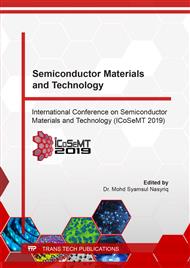[1]
A. Klein et al., Transparent conducting oxides for photovoltaics: Manipulation of fermi level,work function and energy band alignment,, Materials (Basel)., vol. 3, p.4892–4914, (2010).
DOI: 10.3390/ma3114892
Google Scholar
[2]
S. Ilican, Y. Caglar, and M. Caglar, Preparation and characterization of ZnO thin films deposited by sol-gel spin coating method,, Journal of Optoelectronics and Advanced Materials, vol. 10, p.2578–2583, (2008).
DOI: 10.1016/j.tsf.2009.03.037
Google Scholar
[3]
T. Sahoo et al., Nanocrystalline ZnO thin films by spin coating-pyrolysis method,, J. Alloys Compd., vol. 491, p.308–313, (2010).
Google Scholar
[4]
A. Mahroug, S. Boudjadar, S. Hamrit, and L. Guerbous, Structural, optical and photocurrent properties of undoped and Al-doped ZnO thin films deposited by sol-gel spin coating technique,, Mater. Lett., vol. 134, p.248–251, (2014).
DOI: 10.1016/j.matlet.2014.07.099
Google Scholar
[5]
D. Guo, Y. Ju, C. Fu, Z. Huang, and L. Zhang, (0 0 2)-oriented growth and morphologies of ZnO thin films prepared by sol-gel method,, Mater. Sci., vol. 34, p.555–563, (2016).
DOI: 10.1515/msp-2016-0076
Google Scholar
[6]
A. Dutta and S. Basu, Modified CVD growth and characterization of ZnO thin films,, Mater. Chem. Phys., vol. 34, p.41–45, (1993).
DOI: 10.1016/0254-0584(93)90117-5
Google Scholar
[7]
A. Kuroyanagi, Properties of aluminum-doped ZnO thin films grown by electron beam evaporation,, Jpn. J. Appl. Phys., vol. 28, p.219–222, (1989).
DOI: 10.1143/jjap.28.219
Google Scholar
[8]
Y. Li, L. Xu, X. Li, X. Shen, and A. Wang, Effect of aging time of ZnO sol on the structural and optical properties of ZnO thin films prepared by sol–gel method,, Appl. Surf. Sci., vol. 256, p.4543–4547, (2010).
DOI: 10.1016/j.apsusc.2010.02.044
Google Scholar
[9]
A. H. Adl, Synthesis and Characterization of Solution Processed ZnO thin films,, Ph.D. dissertation, Department of Electrical and Computer Engineering, University of Alberta, Canada, (2016).
Google Scholar
[10]
K. L. Foo, M. Kashif, U. Hashim, and M. E. Ali, Fabrication and characterization of ZnO thin films by sol-gel spin coating method for the determination of phosphate buffer saline concentration,, Curr. Nanosci., vol. 9, p.288–292, (2013).
DOI: 10.2174/1573413711309020020
Google Scholar
[11]
A. B. Yadav, C. Periasamy, and S. Jit, Study of post annealing effects on structural and optical properties of sol-gel derived ZnO thin films grown on n-Si substrate,, in 2015 IOP Conf. Ser. Mater. Sci. Eng., vol. 73, (2015).
DOI: 10.1088/1757-899x/73/1/012060
Google Scholar
[12]
L. Znaidi, G. J. A. A. Soler Illia, S. Benyahia, C. Sanchez, and A. V Kanaev, Oriented {ZnO} thin films synthesis by sol-gel process for laser application,, Thin Solid Films, vol. 428, p.257–262, (2003).
DOI: 10.1016/s0040-6090(02)01219-1
Google Scholar
[13]
M. D. Tyona, A theoritical study on spin coating technique,, Adv. Mater. Res., vol. 2, p.195–208, (2013).
Google Scholar
[14]
S. Chakrabarti, D. Ganguli, and S. Chaudhuri, Substrate dependence of preferred orientation in sol–gel-derived zinc oxide films,, Mater. Lett., vol. 58, p.3952–3957, (2004).
DOI: 10.1016/j.matlet.2004.09.002
Google Scholar
[15]
J. F. Chang, H. H. Kuo, I. C. Leu, and M. H. Hon, The effects of thickness and operation temperature on ZnO : Al thin film CO gas sensor,, Sensors Actuators, B Chem., vol. 84, p.258–264, (2002).
DOI: 10.1016/s0925-4005(02)00034-5
Google Scholar
[16]
M. Singh and M. Singh, Thermal expansion in zinc oxide nanomaterials,, Nanosci. Nanotechnol. Res., vol. 1, p.27–29, (2013).
Google Scholar
[17]
M. Z. M. Yusoff, M. R. M. Said, M. B. Yunus, and A. H. A. Hamid, Surface characteristics of zinc oxide grown on different substrates by RF sputtering technique,, Engineering, Science, and Technology Colloquium, vol. 2, p.75–76, (2017).
Google Scholar
[18]
S. Cho, Y. Joshi, V. Sundaram, Y. Sato, and R. Tummala, Comparison of thermal performance between glass and silicon interposers,, in 2013 Proceedings - Electronic Components and Technology Conference, 2013, p.1480–1487.
DOI: 10.1109/ectc.2013.6575767
Google Scholar
[19]
Information on http://www.kymatech.com/about/faqs/427-what-is-the-story-.
Google Scholar
[20]
T. Ashida et al., Thermal transport properties of polycrystalline tin-doped indium oxide films,, J. Appl. Phys., vol. 105, (2009).
Google Scholar
[21]
Information on https://global.kyocera.com/prdct/fc/list/material/alumina/alumina.html.
Google Scholar
[22]
Information on https://www.accuratus.com/alumox.html.
Google Scholar
[23]
C. Prakash, Thermal conductivity variation of silicon with temperature,, Microelectron. Reliab., vol. 18, p.333, (1978).
Google Scholar
[24]
Y. Okada and Y. Tokumaru, Precise determination of lattice parameter and thermal expansion coefficient of silicon between 300 and 1500 K,, J. Appl. Phys., vol. 56, p.314–320, (1984).
DOI: 10.1063/1.333965
Google Scholar
[25]
Information on http://www.kymatech.com/about/faqs/427-what-is-the-story-.
Google Scholar
[26]
Information on ttps://www.phoenixtechnologies.net/media/371/PET%20Properties%202008.
Google Scholar
[27]
M. A. Saada, S. Chikh, and L. Tadrist, Effect of substrate thickness and thermal conductivity on an evaporating sessile drop,, J. Phys. Conf. Ser., vol. 395, p.12140, (2012).
DOI: 10.1088/1742-6596/395/1/012140
Google Scholar
[28]
N. Sahu, B. Parija, and S. Panigrahi, Fundamental understanding and modeling of spin coating process: A review,, Indian J. Phys., vol. 83, pp.493-502, (2009).
DOI: 10.1007/s12648-009-0009-z
Google Scholar
[29]
S.-N. Bai, Effect of substrate on ZnO thin films synthesized by sol-gel method,, Optoelectron. Adv. Mater. Rapid Commun., vol. 4, p.654–656, (2010).
Google Scholar
[30]
S. Hussain, Y. Khan, V. Khranovskyy, R. Muhammad, and R. Yakimova, Effect of oxygen content on the structural and optical properties of ZnO films grown by atmospheric pressure MOCVD,, Prog. Nat. Sci. Mater. Int., vol. 23, p.44–50, (2013).
DOI: 10.1016/j.pnsc.2013.01.006
Google Scholar
[31]
A. A. M. Ralib, A. N. Nordin, N. A. Malik, and R. Othman, Dependence of preferred c-axis orientation on RF magnetron sputtering power for AZO/Si acoustic wave devices,, in 2015 Symposium on Design, Test, Integration and Packaging of MEMS/MOEMS (DTIP), 2015, p.1–6.
DOI: 10.1109/dtip.2015.7160990
Google Scholar


